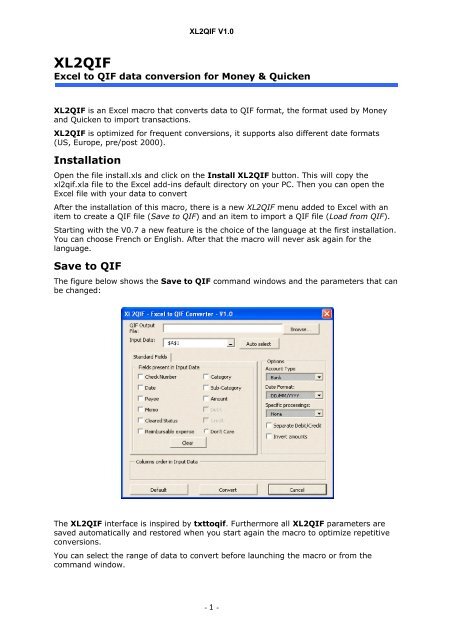
Xl2qif Excel 2010
Contents • • • • • • • • • • • Background [ ] Although still widely used, QIF is a format older than (OFX). The inability to reconcile imported transactions against the current account information is one of the primary shortcomings of QIF.
Date Format Converter is a handy and useful addin for Microsoft® Excel® 2010 or 2007, which helps you convert the text format cells to date&time format cells. Addin for Microsoft ® Excel ® 2010 or 2007.
[ ] Most personal money management software, such as, and Quicken's low end products (e.g. Quicken Personal and Quicken Personal Plus), can read QIF files to import information. Used to be able to import QIF, too, but with its 2006 version it dropped that support for several important account types, including checking, savings, and credit card accounts. The Australian version of Quicken still allows the importing of QIF files for these account types.

However, unlike the American version, it is not possible to export data to QIF or any other file type for any account type. The QIF format does not allow a user to mark the currency in which a transaction was completed.
In some cases this may cause problems for users who do use multiple currencies when they export or import into another software package. Quicken's proposed replacement for the QIF format has been the format. It is commonly supported by financial institutions to supply downloadable information to account holders, especially by banks that support integration of Money or Quicken with their online banking. Not everybody, however, was, or is, happy with this replacement. Some banks dislike it because Quicken (Intuit) charges licensing fees to use QFX. Other banks pass the fees on by charging customers for downloading QFX files. Because Microsoft Money imports either QIF or OFX format files, and Microsoft does not charge banks any licensing fees to use OFX for Money, banks do not normally charge for downloading QIF and OFX files.
(QIF and OFX are open formats, free for anyone to use.) Data format [ ] A QIF file typically has the following structure:!Type: [type identifier string] [single character line code]Literal String Data. ^ [single character line code]Literal String Data. ^ Each record ends with a ^ (caret). All the data in the file is stored in strings, and the file could be edited in any. Simple example!Type:Bank D03/03/10 T-379.00 PCITY OF SPRINGFIELD ^ D03/04/10 T-20.28 PYOUR LOCAL SUPERMARKET ^ D03/03/10 T-421.35 PSPRINGFIELD WATER UTILITY ^.etc. Header line [ ] The first line in the file must be a header line, to identify the type of data contained. • In fact, QIF files are the only format files that Quicken Personal and Quicken Personal Plus can import.
Archived from on 9 June 2007. Retrieved 13 June 2007. CS1 maint: Archived copy as title () • • Atkins, Derek (2014-09-17). Retrieved 17 September 2014.
The QIF format does not mark currency. When you import a QIF into GnuCash Desktop you may select one (and only one) currency per import, and that is applied to all transactions in that import. • Ralls, John (15 December 2013). Retrieved 17 September 2014. Novel buya hamka tenggelamnya kapal van der wijck pdf to jpg. The QIF is an old and rather broken file format. And fails to define important data (such as the currency denomination).
• • • • External links [ ] •. Archived from on 2010-02-22. Look for def extract(path).
Script provided.
I found a useful Excel-to-qif converter (freeware) here: which takes data from my Excel file and makes it importable into MSMoney. However, it ignores the MS Money 'Category' data, even when I have definitely selected those columns in the Excel file for the Add-in to work with. I don't know how to edit/modify the add-in myself and I can't ask the person who built it, because their contact details are out of date and their email bounces. Is there anyone out there that would be willing to take a look and see if they can suggest a way forward? Thanks in advance. I'm using Office 2007 and Windows 7 Ultimate.